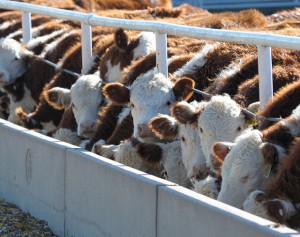by A.J. Tarpoff, DVM, MS, Beef Extension Veterinarian
The use of antibiotics in feed for food producing animals has come under scrutiny over the past few years. The growing issues with bacteria developing resistance to medically important antibiotics in human medicine have been a major driver of these changes. The FDA has put the use of medically important antibiotics under the guidance of veterinarians. The Veterinary Feed Directive (VFD) is the way in which veterinarians will work with producers to ensure the judicious use of these antibiotics with FDA oversight. Many of the antimicrobial medications affected are currently sold over the counter, but will soon be under VFD status.
As of January 1, 2017, the new VFD rules will be in full effect. Medically important antibiotics will no longer be labelled or be used for growth promotion practices. Many currently over the counter antibiotics will be changed to VFD status. Use of these antimicrobials by producers must be authorized by their veterinarian in the form of a VFD.
VFD Defined
A VFD is a written statement authorizing the use of a medically important antibiotic in or on the feed (this includes milk and milk replacer). The VFD form will contain the veterinarian and client’s contact information, the location of the animals, date of approval, expiration date of the order, name of VFD drug, type of animal being fed, number of animals to be fed, indication for the drug, level of the drug in the feed, any withdrawal or special instructions, number of refills if ordered, correct statement indicating no off label use, and the veterinarians signature.
Veterinary Client Patient Relationship (VCPR)
A producer must obtain a VFD from a licensed veterinarian before a feed with a medically important antibiotic can be purchased. In order to grant a VFD to a producer, the veterinarian must be licensed to practice in the state of which the animals to be fed the VFD drug reside. The producer and veterinarian must also have an ongoing working relationship. This is what is referred to as a Veterinary Client Patient Relationship (VCPR). To initiate a VCPR the veterinarian must be familiar with the producer’s operation, assume responsibility for making medical decisions on the animals involved, and have had medically timely visits to the premise. The producer agrees to follow veterinary directions and the veterinarian must be available for follow up. Through this agreement, the local veterinarian will be a partner and guide for the producer during the transition to VFD.
VFD Drugs
VFD drugs are antibiotics that are used in food producing animals that are medically important in human medicine. The most common drugs that will be affected are the tetracyclines (chlortetracycline, oxytetracycline), Sulfas, Tylosin, Neomycin, and Virginiamycin. The classes of drugs that will not be affected by the VFD are the ionophores, babermycins, bacitracin, tiamulin, and coccidiosis treatments (such as Decoxx and Corid). However, if these drugs not affected by the VFD are fed in combination with a VFD drug (Rumensin/Tylan) then a VFD must be obtained. VFD drugs can only be used under the specific FDA approved label directions. The directions on the label are for the indication (treatment or control of a disease), dose (the amount fed each day), and duration (days the animals are fed the drug). It is also important to understand that only approved combinations of drugs can be fed. Extra label use of feed medication is not permitted under any circumstances. Veterinarians can only issue a VFD for labelled directions.
Expiration and Duration of VFDs
VFDs contain an expiration date. The expiration date on the VFD is not the same as the duration of use. Duration of use is the period of time which the animals should be fed the VFD drug for label indication. An example of this is feeding Aureomycin at 10 mg/lb body weight (dose) for not more than 5 days (duration) to treat bacterial pneumonia in calves (indication). The expiration is the last day of the authorization to feed a VFD. The FDA has set a maximum of 6-month expiration on a VFD order. Some medications have a much shorter expiration. If a producer still has VFD feed on hand, but the expiration date has passed, a new VFD must be made to legally continue to feed the VFD feed.
Record Keeping
The producer may receive a VFD order from their veterinarian in hard copy or electronic form. Three copies of the VFD order are made. The original will be kept by the issuing veterinarian, one copy will be sent to the feed distributor, and the other copy will be given to the producer. These orders must be kept on file by the producer for 2 years after the issuing of the VFD. If an FDA inspection occurs, the VFD order must be provided upon request.
